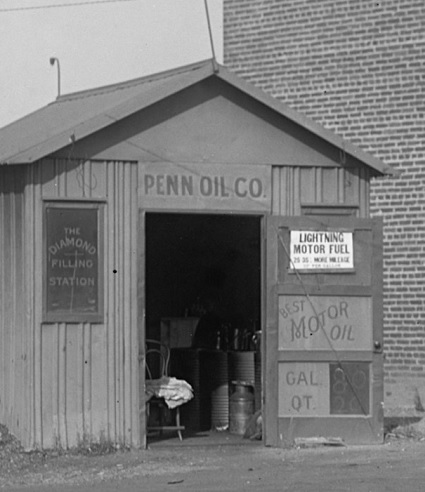Diamond Filling Station
As more Americans took to the road, inventor S.F. Bowser added a hose attachment for dispensing gasoline directly into automobile tanks in 1905. His popular Model 102 Chief Sentry with its secure “clamshell” cover followed.
The man wearing overalls and a bowler hat pumps gas at the Diamond Filling Station in 1920 at the corner of Massachusetts Avenue and North Capitol Street near Union Station in Washington, D.C.
The Library of Congress photograph of the scene (with the station’s owner?) includes an S.F. Bowser Pump Company Model 102 Chief Sentry with a hand lever that pumped Penn Oil Company lightning Motor Fuel. A quart of Penn Oil motor oil sells for 20 cents.

Manufactured in 1911, an S.F. Bowser Model 102 Chief Sentry is pumped by the station attendant on North Capitol Street in Washington, D.C., in 1920. Photo courtesy Library of Congress Prints and Photographs Division.
“This is so cool. So, when you had to pump your gas, you literally had to hand pump the equipment to get the gas to come out?” asks one vintage photographs website blogger. “I’ve honestly never thought about the literal meaning of a phrase that I say all the time. And I feel like a total whippersnapper by asking the question.”

The small “filling station” sold Penn Oil Company’s Lightning Motor Fuel. Four quart of Penn Oil motor oil sold for 80 cents.
According to the blog Shorpy.com, the photograph and others were taken in the Washington, D.C., area by the National Photo Company, whose archive of thousands of negatives (mostly glass plates) and prints was donated by proprietor Herbert E. French to the Library of Congress in 1947.
The popular Bowser “Chief Sentry” pump included an upper clamshell that closed for security when the filling station was left unattended. Showing its wear and tear, the nine-years-old pump’s topmost globe (prized by collectors) survived only as a bare bulb.
Sylvanus Freelove Bowser of Ft. Wayne, Indiana, in 1885 sold his first accurate pump that could reliably measure and dispense kerosene – a product much in demand.

S.F. Bowser added a hose attachment for dispensing gasoline directly into automobile tanks in 1905. His popular Model 102 “Chief Sentry” with its secure “clamshell” cover followed.
Later, as America’s enthusiasm for “horseless carriages” soared, so did demand for gasoline. Bowser refocused his business on gasoline pumps to serve increasing numbers of customers driving automobiles. Bowser’s Self-Measuring Gasoline Storage Pumps soon became known as “filling stations.” Also see Cantankerous Combustion – 1st U.S. Auto Show.
Penn Oil Company was the exclusive American distributer of Lightning Motor Fuel, a British product that reportedly consisting of “50 percent gasoline and 50 per cent of chemicals, the nature of which is secret.”
Lightning Motor Fuel was promoted as offering up to 35 percent more mileage thanks to its secret ingredient, which was likely alcohol. Some writers of the day believed alcohol would eventually replace gasoline refined from petroleum.
“The advantage of alcohol over petrol for this purpose lies principally in the fact that whereas the world’s supplies of petroleum, and therefore of petrol, are being gradually exhausted, the supply of Power Alcohol is practically inexhaustible,” proclaims one 1925 trade journal, Romance of the Fungus World.
The journal added that alcohol’s fuel potential was “only limited by the earth’s capacity of producing plant growths whose products are amenable to the fermentative processes which yield alcohol.”
Today, ethanol is a common additive, but neither Bowser Pump Company, Penn Oil Company, nor Lightning Motor Fuel survived. The last vestige of Bowser Pump Company disappeared from Ft. Wayne in 1969. Learn more in First Gas Pump and Service Station.
_______________________
The American Oil & Gas Historical Society preserves U.S. petroleum history. Please become an AOGHS supporter and help maintain this energy education website and expand historical research. For more information, contact bawells@aoghs.org. Copyright © 2025 Bruce A. Wells. All rights reserved.
Citation Information: Article Title – “Diamond Filling Station.” Authors: B.A. Wells and K.L. Wells. Website Name: American Oil & Gas Historical Society. URL: https://aoghs.org/products/diamond-filling-station. Last Updated: May 10, 2025. Original Published Date: July 9, 2014.



